Home > Highlighting JAPAN > Highlighting Japan FEBRUARY 2013 > Buildings for All Seasons
Highlighting JAPAN
COVER STORY: WINTER WONDERLAND
Buildings for All Seasons
In regions with heavy snowfalls, the cost to homes and businesses of snow removal and snow melting is high, and energy consumption for heating in winter continues to increase. However, technologies for reducing energy consumption that utilize the cold and snow as energy sources are beginning to come into widespread use. Masaki Yamada and the Japan Journal's Osamu Sawaji report.
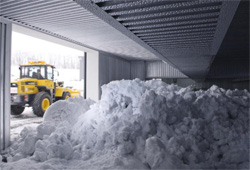
A power shovel is used to transport snow to the snow room in the Okudaisen Bunanomori Water Plant in Kofu-cho, Tottori Prefecture.
Credit: COURTESY OF SUNTORY
In snowy regions, snow removal is a major challenge. The cost of snow removal and the securing of places where the removed snow can be dumped are a big headache for local communities. Hope is at hand in the shape of technologies that use this snow as a source of energy.
The most popular method is to store snow that has fallen during the winter, and ice made from the cold outside air, and to utilize that cold air and cold water for crop storage and air-conditioning right through until summer. For example, a storage facility for brown rice in Bibai City in central Hokkaido stores 6,000 tons of brown rice using 3,600 tons of snow. The temperature inside the storehouse is maintained at 5°C, preventing deterioration of flavor. At New Chitose Airport, the aerial gateway to Hokkaido, snow is stored on a corner site 100 m long by 200 m wide. The snow melt that flows from this snow storage facility, said to be the largest in the world, is used for air conditioning of the airport building in summer. This provides 20–30 per cent of the energy used in the building as a whole.
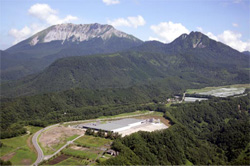
The Okudaisen plant is open to members of the public by appointment, and receives more than 8,000 visitors each year.
Credit: COURTESY OF SUNTORY
The Okudaisen plant is situated at the foot of Mount Daisen (1,729 m), the highest peak in the Chugoku region of southwest Japan, and produces mineral water using water pumped from within the site. Densely wooded with a vast forest of Japanese beech, this is one of the heaviest snowfall areas in the Chugoku region, with 1–2 meters of snow accumulating in winter.
The snow room of the Okudaisen plant is able to store up to about 250 tons of snow. In this region, snow begins to fall in earnest from around December. The snow that accumulates within the site is collected using a power shovel and transported to the snow room. By January, the snow room is normally full of snow.
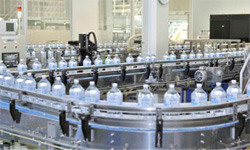
The mineral water production line at Okudaisen Bunanomori Water Plant. The snow from the snow room is used to cool the heat generated by the production line
Credit: COURTESY OF SUNTORY
At the same time, however, the company was able to dramatically curb the consumption of fuel required to transport the snow, since it takes around 30 tons of snow from the snow room per day to cool this heated water. In January 2011, around 500 tons of snow, enough to fill 200 dump trucks, were melted without being transported off-site.
In summer on the other hand, the snow in the snow room is used as cold water for air conditioning inside the plant. The inside of the snow room is well insulated, so the snow that has been stored in winter is still there by the time summer comes.
With the use of this snow room reducing the electricity required for air conditioning and cooling, the Okudaisen plant has succeeded in curbing carbon dioxide (CO2) emissions by around 5 tons per year.

Publicity image of a CASART TERRA home
Credit: COURTESY OF PANAHOME
With the demand for eco-friendly goods in recent years, people in Japan are taking far more interest in the creation of electric power using natural energy in ordinary homes, and in energy saving products such as low power consumption air conditioning, heating, and household electrical appliances.
As far as the use of natural energy in ordinary homes is concerned, the use of solar power generation systems in particular is becoming increasingly widespread with the support of national and local governments. According to a survey by the Japan Photovoltaic Energy Association, as of April 2012 the total number of residential solar power generation systems installed in Japan has passed the one million mark.
However, the disadvantage of the solar power generation system is that power generation is affected by the weather. On rainy or cloudy days, reduced power generation is unavoidable.
In this context, leading manufacturer of residential homes PanaHome developed homes that use geothermal power, a stable natural energy that is not affected by the weather.
"We came up with the Comprehensive Home Solution that wraps the entire house in insulation, from ceiling to external walls to the foundations, utilizing the natural heat of the earth. The basis of that concept is to see the space under the floorboards as a space that utilizes geothermal heat," says Seishi Shiote, chief manager of the House Planning and Product Development Department of PanaHome. "Instead of cutting off the space under the floorboards from the living space by attaching insulation materials to the under side of the floorboards as is the case with regular homes, it takes in geothermal heat directly."
In this case, the geothermal heat is different from that which hails from the interior of the earth, such as magma; the sort which is used in the generation of electric power. Geothermal heat used in the Comprehensive Home Solution is heat that is heated (or cooled) by sunlight and air and stored in the earth. This ground source heat is not easily influenced by changes in temperature caused by the seasons or weather conditions, and the heat from approximately 10 meters below the ground is maintained at around the annual average temperature (in Tokyo, around 16°C.)
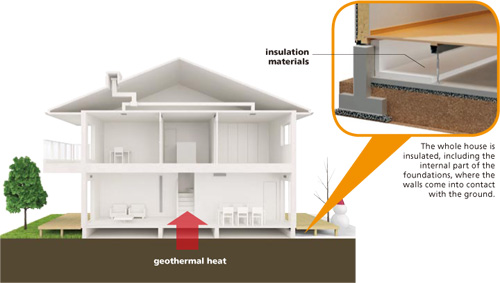
The award-winning Comprehensive Home Solution system is designed to take in geothermal heat directly.
Credit: COURTESY OF PANAHOME
The ECO NAVI Ventilation System exploits that air under the floorboards. With this system, sensors measure the difference in temperature between the inside and the outside of the home and automatically control the amount of ventilation depending on the temperature difference. In winter, air heated under the floorboards is automatically taken into the room. In summer, when the room temperature rises, cold air from under the floorboards is brought into the room using a fan. While this is simply ventilation rather than air conditioning or heating, this system reduces the energy for cooling and heating.
In this way, it is possible to realize energy savings using natural energy without installing large-scale equipment. When a comparison is made using the same criteria between a household of an assumed four family members (total floor area 123 m2) and the CASART TERRA home that has introduced the Comprehensive Home Solution and ECO NAVI Ventilation System, the yearly heating and lighting expenses for the CASART TERRA is around a quarter of the yearly heating and lighting expenses for a regular home. Further, the annual volume of CO2 emissions can be reduced from 3.55 t to 1.40 t. Residents living in CASART TERRA homes say how happy they are to be able to live in such a large house and not have to worry about their electric bill, while at the same time being able to help the environment without being aware of it.
The Comprehensive Home Solution and the ECO NAVI Ventilation System are without parallel in the world and their outstanding energy-saving features are regarded very highly, receiving the Minister's Prize from the Ministry of Land, Infrastructure, Transport and Tourism in the 9th Eco-Products Awards (Eco-Products Category) in Japan in 2012.
Indispensable Items for Protection against the Cold
In Japan, there are many handy products to keep one feeling warm and comfortable when the temperature drops. The following items are popular with all age groups, and for many are considered indispensable in the winter months.
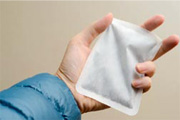
A standard sized disposable hand warmer
When the cold becomes severe and the hands and feet are freezing, the time has come to get out the kairo!
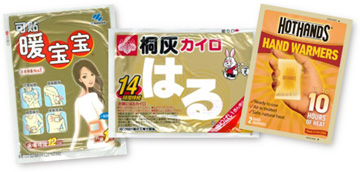
Disposable body warmers sold by Kobayashi Pharmaceutical Co. These products are sold in China (left), Japan (center) and the United States (right).
Credit: COURTESY OF KOBAYASHI PHARMACEUTICAL CO., LTD.
Many people use kairo habitually as a simple and portable product for staying warm when working outside in winter, or commuting to school or work. In addition to the regular and mini size pouches, there are kairo that attach to clothing or inserted into shoes. According to the Japan Disposable Body Warmer Manufacturers Association, more than 2 billion kairo were sold in Japan between May 2011 and April 2012.
These handy disposable body warmers are also becoming popular overseas where they are used in ways that suit the circumstances in each country or region. Kobayashi Pharmaceutical Co., for example, sells disposable body warmers in twenty countries and regions around the world including China, Hong Kong, Japan, Taiwan, the United Kingdom and United States. According to the company, the most common usage in North America, for example, is to put a mini pouch in the left and right pockets to keep the hands warm when leaving the house. In China, the pouches that can be attached to clothing are very popular. In the north of the country, there is also particularly high demand for feet warmers. In the comparatively warm southern areas of China, the body warmers are valued as one of the options for staying warm during the short winter because houses are not equipped with proper heating systems.

Colorful, patterned HeatTech for women on display at a Uniqlo store in Japan. When the winter cold gets severe, large quantities of HeatTech sell in no time at all.
The HeatTech products on sale differ with the country and region. Depending on the season, there are also periods when HeatTech products are not available.
Credit: TADASHI AIZAWA
The conventional wisdom has been to wear heavy sweaters, coats and other thick clothes for protection against the cold in winter. Now, in Japan, putting on thin, light and warm "functional innerwear" is the first thought for many.
Functional innerwear uses the moisture that evaporates from the body to generate heat, and by trapping the heated air in the fibers, it ensures that the heat is retained. The fabric has a smooth texture that is form-fitting and feels pleasant to wear. The products vary, but there are some that combine warmth with other functions such as elasticity, sweat absorption and quick-drying functions, anti-static, antibacterial and odor-resistance functions.
Many companies including apparel makers and private supermarket brands now sell functional innerwear, including long-sleeve or half-sleeve tees, tights and children's innerwear. There are plenty of colors and patterns for women's products, which can also be enjoyed as fashion items and not only worn underneath outerwear. Modern functional innerwear has evolved from the heat insulating innerwear for outdoor use worn only at particular times, to winter clothing that many Japanese people wear in everyday life.
The boom in functional innerwear was sparked when Uniqlo Co. started selling its HeatTech products in 2003. Since the initial launch, HeatTech products have been continuing to evolve by adding and improving a range of functions in pursuit of further smoothness and softness to the touch. The HeatTech now has 10 different type of functions and comes in men's and women's ranges. In 2008, Uniqlo launched a full-scale overseas sales of HeatTech and they distributed giveaways to passing pedestrians as part of a global campaign in the five cities of New York, London, Paris, Beijing and Seoul. Subsequently, many people who tried the HeatTech products reacted with surprise at how the comfort and warmth of the HeatTech products contrasted with the apparently thin fabric. Today, HeatTech is sold in thirteen countries and regions worldwide including China, Japan, Russia, Singapore, Thailand, the United Kingdom and United States, and global sales for the period from April 2012 to March 2013 are targeted to reach approximately 130 million items.
© 2009 Cabinet Office, Government of Japan






